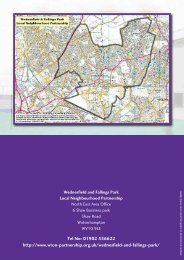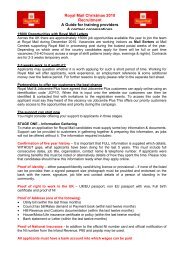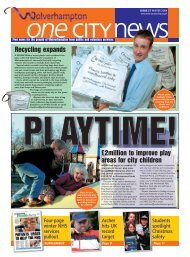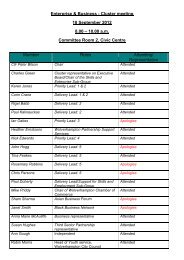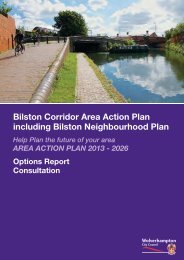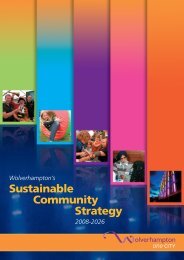Stafford Road Corridor Area Action Plan
Stafford Road Corridor Area Action Plan
Stafford Road Corridor Area Action Plan
Create successful ePaper yourself
Turn your PDF publications into a flip-book with our unique Google optimized e-Paper software.
locations were identified including the railway viaducts,islands along the <strong>Stafford</strong> <strong>Road</strong>, Three Tuns Centre,M54 junction, canal and the Cannock <strong>Road</strong>. A numberof areas were also highlighted as priority sites to helpimprove the area, including Bluebird Trading Estate andthe Goodyear site redevelopment. Key assets wereidentified as important to keep/improve in the area,including Fowlers Playing Fields and Bee Lane.EvidenceFour pieces of evidence have considered issues ofdesign, historic character and local distinctiveness in theAAP. These are the Detailed Historic LandscapeCharacterisation (HLC) Study, <strong>Stafford</strong> <strong>Road</strong> <strong>Corridor</strong>Baseline Audit, Phase 2 Black Country EnvironmentalInfrastructure Guidance and the Wolverhampton LocksConservation <strong>Area</strong> Appraisal.Townscape analysis of the <strong>Stafford</strong> <strong>Road</strong> <strong>Corridor</strong>classified much of the industrial and residential sites inthe area as being adequate or poor in terms of overalltownscape quality. First impressions are negative forthose arriving in the City and moving through the<strong>Corridor</strong> via its many gateways, focal points andfrontages, with a few notable exceptions. Unattractiveemployment areas, cleared derelict sites and areas ofundistinguished housing all contribute towards an overallpoor perception of the <strong>Corridor</strong>.The <strong>Stafford</strong> <strong>Road</strong> <strong>Corridor</strong> contains very fewdesignated heritage assets but it is known to have beenan important route between the historic centres ofWolverhampton and <strong>Stafford</strong>. In the 18th and 19thcenturies it became a main corridor for transportation bycanals and then railways. These transport routes definethe area; road, rail and, to a lesser extent, the canals.The historical development of these routes, togetherwith associated industrial and subsequent residentialdevelopment has made an indelible impression on thecharacter of the area.The HLC Study has included a comprehensive survey toidentify previously unrecognised heritage assets whichcontribute towards the overall historic character of thearea together with an assessment of their significance. Ithas categorised these assets based on the potentialthey have to be catalysts for regeneration and theirheritage value (Category 1 & 2) and their townscapevalue (Category 3). The whole area has also beendivided into locally distinctive character areas and thecontribution that the historical development of the areahas made to its present character can now be moreclearly understood and appreciated. Recognising whatis special about the area and what makes it distinctive isa useful first stage in engendering a sense of placewhich will be vital to the ongoing regeneration of thearea for local residents and the business community.Results of the HLC can be used by everyone involved inplanning for the future of the <strong>Corridor</strong> to ensure thatforthcoming development proposals take into accountthe known heritage assets and locally distinctiveelements of the area. Together with the townscapeanalysis of the area, opportunities can now be identifiedwhere public realm improvements can be focussed andnew development which can positively augment localcharacter can be encouraged. This will assist inpromoting a more cohesive approach to place makingthroughout the <strong>Plan</strong> area to achieve the aims of theoverall policy.A new appraisal of the Wolverhampton LocksConservation <strong>Area</strong> has been undertaken as part of theevidence gathering for the AAP. The Birmingham Canalpasses through the south-west part of the <strong>Stafford</strong> <strong>Road</strong><strong>Corridor</strong> and where it has an important historicalrelationship with bordering industrial sites and laterrailway features that particularly characterise this part ofthe <strong>Corridor</strong>. Character <strong>Area</strong> 2 of the Conservation <strong>Area</strong>Appraisal (from Cannock <strong>Road</strong> to Oxley Viaductcovering Locks 6 through to 16) lies within the corridor.The appraisal contains a number of managementproposals for the Conservation <strong>Area</strong> and onerecommendation for an extension to the designated areato include important archaeological remains of coalingstages and a railway engine turntable in Fowlers PlayingFields open space.Options and Preferred Policy ApproachFour key areas need to be addressed by the AAP ondesign, each with their own options and Preferred PolicyApproach. These elements could form separate policieson these issues, or elements could be incorporatedwithin other parts of the AAP, specifically Part 3 on sites.Conserving and Enhancing the HistoricEnvironmentThe HLC concluded that there is little overall coherentsurvival of historic character throughout the area interms of standing buildings or historic form, howeverthere are small pockets of surviving late 19th / early 20thcentury buildings that contribute towards a sense ofplace. There are also sections of two canal basedConservation <strong>Area</strong>s, and highly significant historicelements of the transport infrastructure that was so vitalto the industrial development of Wolverhampton, muchof which is still operational. The surviving andfragmentary remains of the heritage of the area arefragile but this is a heritage that nonetheless deserves toOptions Report for the Development of the <strong>Stafford</strong> <strong>Road</strong> <strong>Corridor</strong>27





